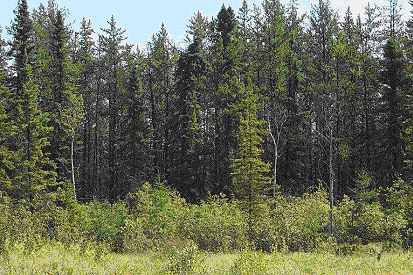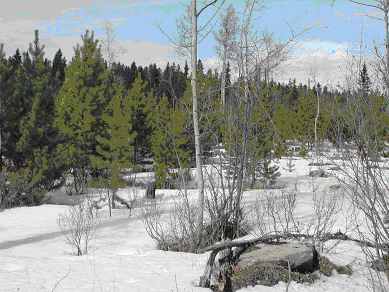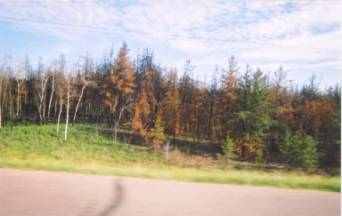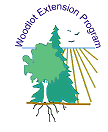| | Growing conditions | Regeneration | Harvesting | Uses
It is quite common for landowners to have jack pine in their woodlots. It is important for landowners to understand the management and value of this tree species. Woodlots, with jack pine, are usually pure but can be a mixed wood of aspen, birch, black and white spruce. Management of a jack pine forest requires many considerations such as biological and ecological characteristics as well as stand health, site quality, and availability of markets, which affects the intensity, timing of harvest operations, and harvesting methods.
Growing Conditions
Jack pine can grow in a wide range of soil types from dry, sandy soil to clay loams but can usually be found in dry acidic sandy soil and in thin soils over bedrock. It is a very wind firm tree except in shallow soils or heavily thinned stands. It is a relatively fast growing medium sized tree and normally reaches between 20 and 25 meters tall. It will not tolerate shade. Common under-story shrubs found in a jack pine stand are prickly rose, bunchberry, bearberry, blueberry, beaked hazelnut and Labrador tea. The groundcover of a jack pine stand usually consists of reindeer lichen and feather moss. It is susceptible to severe losses from fire, insects, disease as well as browsing by deer or moose. Many insects and diseases attack jack pine trees but dwarf mistletoe is the most recognizable disease to the landowners.

Picture 1. Mature jack pine stand
Regeneration
Jack pine quickly occupies areas where mineral soils have been exposed to major disturbances such as fire and if there is seed source are close by. Although fire can easily kill a jack pine stand, it also plays an important role in establishing new stands this process results in even-aged stands. Jack pine trees produce seed every year. However, most of the cones remain closed holding on to their seed until high temperatures such as fire or sun open them. Natural regeneration usually occurs after fire or harvesting. Clear-cutting the pine trees will distribute the seed source evenly over the cut-block. Having the cones close to the ground potentially allows them to experience extreme summer temperatures. A jack pine stand can also be regenerated through planting. However, protection of young jack pine stand from deer, moose, elk, rabbits and other animals may be necessary. Jack pine seedlings require full sunlight to become established. For the first 20 years, its one of fastest growing coniferous species. Jack pine start to show signs of decadence around 75 years of age whish is considered as mature forest for jack pine.

Young jack pine stand with young aspen and white spruce
Harvesting
Clear-cutting is the most accepted method of harvesting a jack pine stand. Other methods such as shelter wood or seed tree harvesting are possible but depend on favourable conditions like seed tree quality, availability of seed and micro-site. Summer or fall harvesting will cause disturbance to the soil, compared to harvesting while the ground is snow covered. However, to increase the possibility of natural regeneration, summer is the best time for harvesting.

Forest fires kills easy jack pine stand but also plays
an important role to establish new pine forest stand
Uses
The quality of a jack pine is linked to its straightness, form, size, and branching habits. Most jack pine stands are used for pulpwood but on better-quality sites it can be used for saw timber, railway ties, power, firewood and fence posts. It machines and treats very well. In old growth, it is common to see red hard stains. Jack pine is also planted for Christmas tree production. Jack pine stands are also very valuable for non-game wildlife. A young jack pine stand is excellent cover for hares. Many birds such as spruce grouse and songbirds use jack pine stands for their habitat. Owls like it for day roosting and hunting. There is also an opportunity for blueberry picking which many landowners enjoy.
Management recommendations for a jack pine stand include:
- Use clear-cutting as a method for harvesting
- Summer is the best time for harvesting to increase the possibility of natural regeneration
- If you are going to regenerate by tree planting, you need to protect the your stands from deer, moose, elk and rabbits
- Jack pine is intolerant to shade, therefore do not plant seedlings in the understory of other tree species
- A young jack pine stand is extremely susceptible to fire, design a strategy for fire protection such as thinning
- Seedling survival maybe low if spring drought is long in germination period
- Jack pine does not tolerate flooding
- It is often the pioneer species in a stand or bare ground
- Dwarf mistletoe maybe eliminated from a stand by clear-cutting however, monitoring after harvesting is necessary. Selective cutting of infested trees is not recommended and will likely increase the spread of disease
- Cut-blocks should be irregular in shape providing more natural edge which is important for a number of wildlife species
- Leave some snags and dead trees for wildlife habitat
 |
|